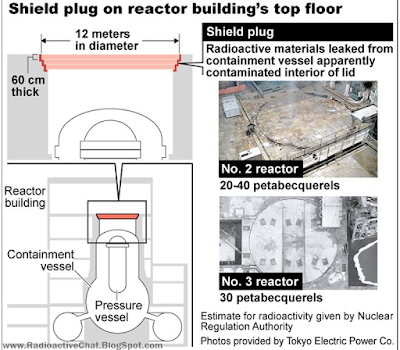Exceedingly high radiation levels found inside crippled reactor buildings at the Fukushima No. 1 nuclear plant were labeled by nuclear regulators as an “extremely serious” challenge to the shutdown process and overall decommissioning of the site.
The Nuclear Regulation Authority (NRA) said a huge amount of radioactive materials apparently had attached to shield plugs of the containment vessels in the No. 2 and No. 3 reactors.
Radiation levels were estimated at 10 sieverts per hour, a lethal dose for anyone who spends even an hour in the vicinity, according to experts.
 |
| Radiation levels at Fukushima plant far worse than was thought |
Toyoshi Fuketa, chairman of the NRA, noted that removing the highly contaminated shield plugs added to the enormous difficulty of retrieving nuclear fuel debris, the most daunting part of the decommissioning process.
“It appears that nuclear debris lies at an elevated place,” he said at a news conference earlier this month. “This will have a huge impact on the whole process of decommissioning work.”
A shield plug, made of reinforced concrete, is circular in shape and measures about 12 meters in diameter.
It has a triple-layer structure, with each layer about 60 centimeters thick. It is placed above the containment vessel like a lid on the top floor of a reactor building.
The shield plug blocks radiation from the reactor core at normal times.
When nuclear fuels need to be replaced, workers remove a shield plug to gain access to the interior of the containment vessel.
In a study that resumed in September after about a five-year hiatus, the NRA carried out fresh measurements of radiation levels in the vicinity of the shield plugs of the No. 2 and No. 3 reactors.
The study was undertaken following investigations by Tokyo Electric Power Co., operator of the plant, and other entities, which had shown extraordinary levels of radiations there.
The NRA’s study found that the amount of radioactive cesium 137 was estimated at 20-40 petabecquerels between the space between the top and middle layers of the shied plug of the No. 2 reactor.
That works out to more than 10 sieverts per hour based on readings of radiation levels nearby. Radiation at such levels can kill a person if they are exposed for an hour, according to experts.
The estimated figure was 30 petabecquerels for the No. 3 reactor.
In the triple meltdown triggered by the 2011 earthquake and tsunami disaster, the shield plug of the No. 1 reactor slipped out of place and was damaged by a hydrogen explosion that occurred at the reactor building.
As larger amounts of cesium 137 leaked from the No. 1 reactor through the damaged plug, the amount of the radioactive material attached to its shield plug was estimated at 0.16 petabecquerels, considerably lower than for the No. 2 and No. 3 reactors.
In contrast, the shield plugs for the No. 2 and No. 3 reactors remained relatively unscathed, blocking a huge amount of radioactive substances that leaked from their containment vessels from escaping into the atmosphere, according to the NRA.
TEPCO announced Dec. 24 that the removal of nuclear fuel debris will be postponed to 2022 or later, rather than the initially scheduled 2021, due to a delay in the development of equipment to carry out the work.
Source: http://www.asahi.com/ajw/articles/14071742








No comments:
Post a Comment